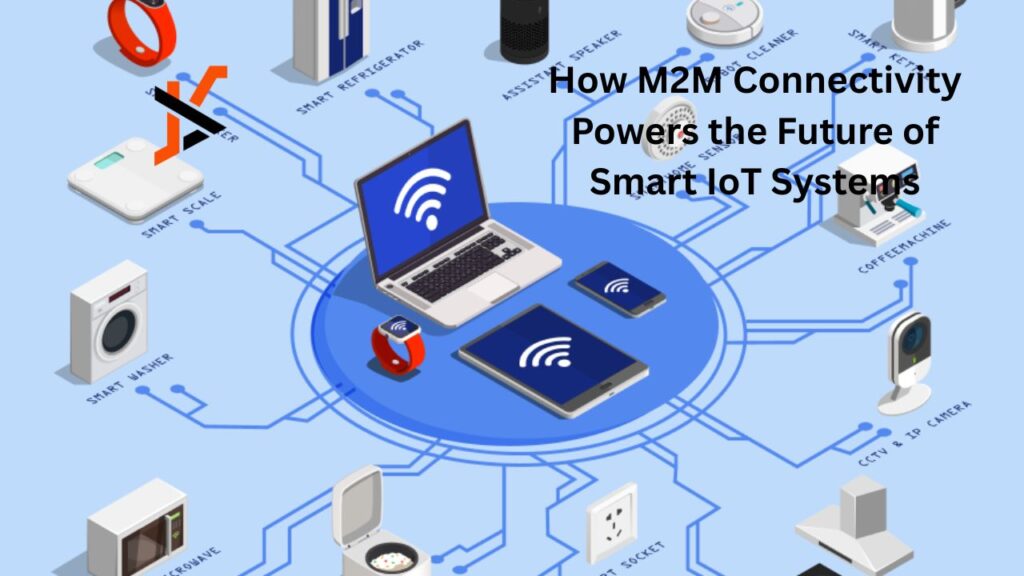What Is Machine-to-Machine Connectivity?
Machine-to-Machine (M2M) connectivity enables devices to exchange information automatically without human intervention. In essence, M2M allows smart devices such as sensors, controllers, and gateways to communicate directly using wired or wireless networks. This technology forms the foundation of the Internet of Things (IoT), driving real-time data exchange, automation, and smarter decision-making across industries.
Whether it’s a sensor transmitting performance data to a monitoring hub or a vehicle sending live location updates, M2M connectivity is transforming how modern systems operate making processes faster, more efficient, and data-driven.
How M2M Works in the IoT Ecosystem
M2M connectivity operates through a powerful cycle: devices collect data, transmit it over networks, and send it to data platforms for analysis. These insights are then used to automate operations and enhance system performance.
Core components of M2M communication include:
- Devices and Sensors: Collect and process real-world data such as temperature, pressure, or location.
- Communication Networks: Transfer data using cellular, Wi-Fi, or satellite connections.
- Data Platforms: Analyse information to produce actionable insights.
- Applications and Interfaces: Display data through dashboards for easy management.
A robust IoT Device Management Platform ensures these components work together seamlessly, providing total visibility, control, and automation across connected devices.
The Role of Wireless M2M Connectivity
Wireless M2M has become the backbone of modern IoT. By using cellular and satellite networks, it eliminates the need for manual data entry or wired systems, allowing machines to communicate instantly across long distances.
Industries such as logistics, healthcare, and energy rely on M2M to manage remote assets, monitor performance, and automate maintenance alerts. For example, a fleet management system can use M2M technology to track vehicles, optimize routes, and trigger maintenance alerts all without human input.
Security and Authentication in M2M Networks
As millions of devices connect and exchange data, security becomes a top priority. Each device in an M2M network must authenticate itself before transmitting data, ensuring protection from cyber threats.
Advanced encryption and authentication protocols secure all communications, while fixed IP SIM cards provide consistent and traceable connections for remote monitoring systems. These safeguards ensure that M2M connectivity remains both reliable and secure.
M2M SIMs: Enabling Seamless Global Connectivity
Reliable connectivity is essential for any M2M ecosystem. Specialised SIM cards designed for M2M and IoT applications ensure devices stay connected across multiple networks with no manual configuration needed.
A M2M connectivity solution allows global deployments to operate smoothly, maintaining strong network performance even when devices move between regions or carriers. Businesses can also manage these SIMs remotely, reducing complexity and ensuring uninterrupted communication for mission-critical applications.
Real-World Applications of M2M Connectivity
M2M is reshaping industries by enabling smart automation and real-time control:
- Smart Cities – M2M networks optimize traffic control, monitor utilities, and enhance urban efficiency.
- Healthcare – Connected medical devices transmit real-time patient data, enabling faster, data-driven care.
- Manufacturing – M2M automates production lines, tracks machinery health, and predicts maintenance needs.
- Agriculture – Smart farming uses M2M for irrigation control, soil monitoring, and livestock tracking.
- Transportation and Logistics – Fleet management systems rely on M2M for route optimisation, asset tracking, and fuel management.
Benefits of Adopting M2M Connectivity
Businesses and governments are turning to M2M for its tangible benefits:
- Automation and Efficiency: Reduces manual processes and operational errors.
- Real-Time Insights: Provides immediate visibility into system performance.
- Scalability: Supports thousands of devices with flexible expansion.
- Cost Efficiency: Reduces downtime and improves resource allocation.
- Global Reliability: Ensures consistent communication across international networks.
The Future of M2M and IoT
With the rise of 5G, edge computing, and AI, M2M connectivity is evolving into an even more intelligent and responsive network layer. Future systems will focus on predictive analytics, autonomous decision-making, and decentralised device management empowering industries to operate smarter with less oversight.
The synergy between M2M, IoT, and emerging technologies is paving the way for a world where machines collaborate seamlessly, unlocking new levels of efficiency and sustainability.
Empowering IoT with Smooth Connectivity
At the heart of every IoT system is reliable communication and that’s exactly what M2M delivers. By combining M2M SIM solutions, secure device management, and fixed IP connectivity, businesses can create future-ready digital ecosystems that thrive on automation and data intelligence.
Smooth Connectivity can help you strengthen your IoT network and harness the full power of M2M technology today.

